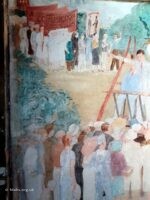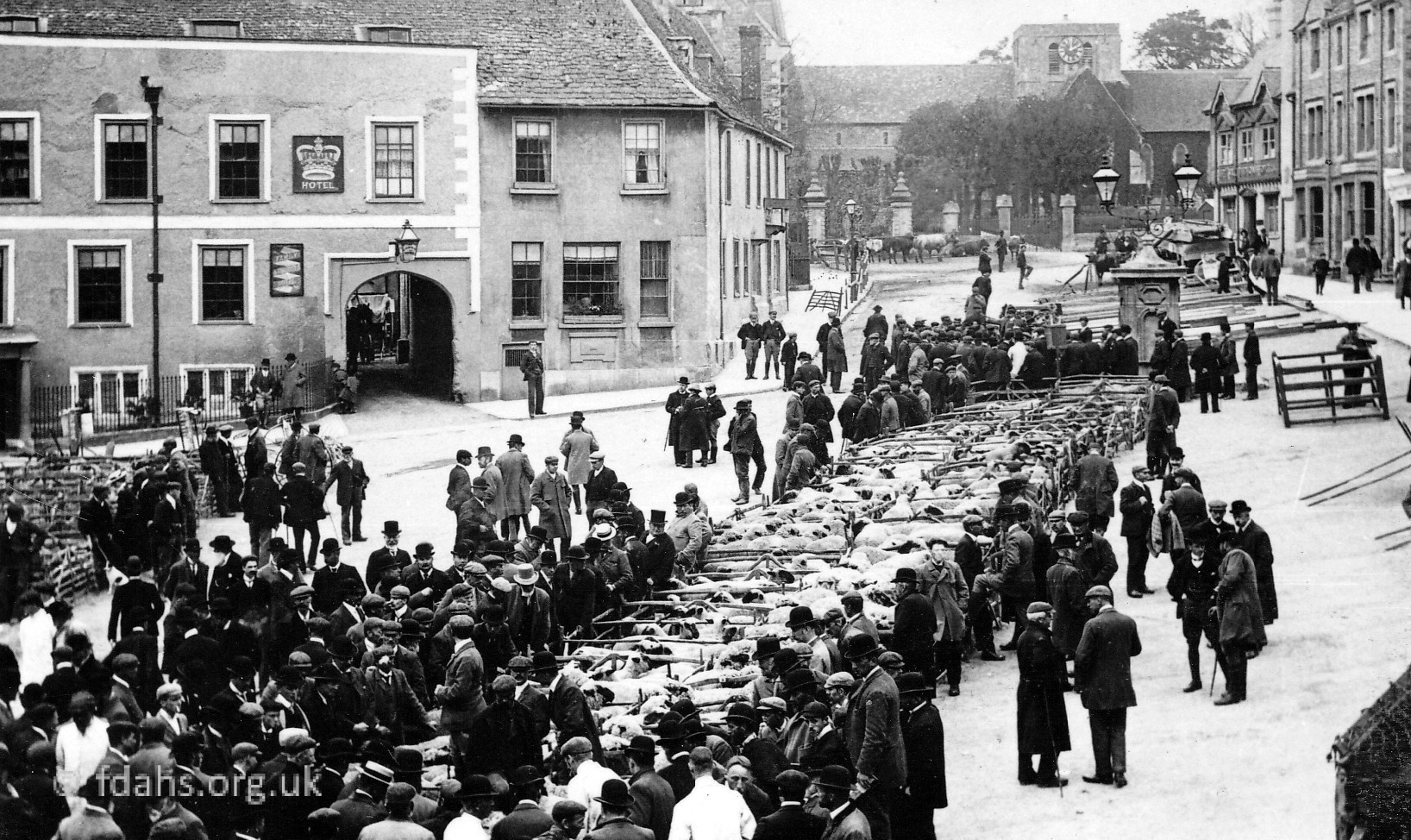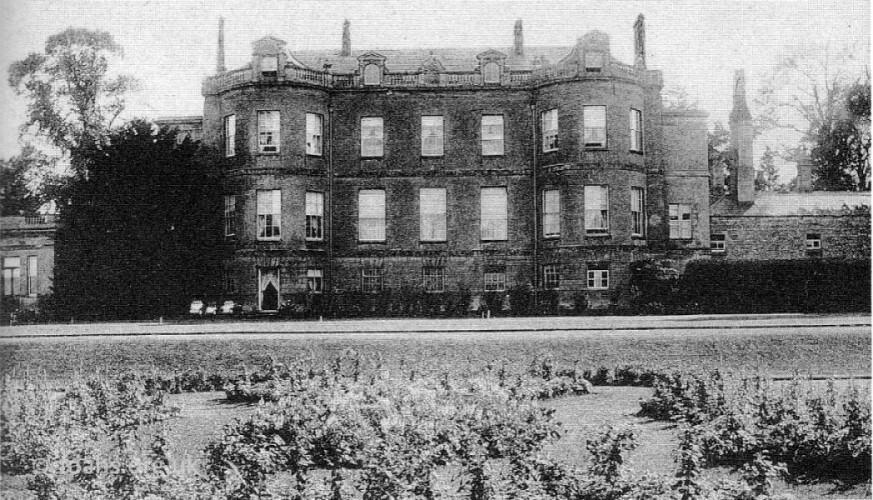Buscot House together with the surrounding park land became the home of Lord Faringdon and there is also a very interesting history under previous owners. It is part of the Buscot and Coleshill Estate, which totals some 7,500 acres comprising of 11 farms, 290 acres of in hand woodland, 550 acres of woodland let to the Forestry Commission, and includes the villages of Buscot, Coleshill, and Eaton Hastings. It is now almost entirely owned by the National Trust (only 4 houses are in private ownership), a total of 151 cottages. Buscot Park and House are on the opposite (south) side of the A417 before reaching the village of Buscot. They are open to the public on set days during the summer months.
Edward Loveden Townsend (1740s–1822)
The Loveden family2 owned the manor in Buscot from 1557 for 300 years. Edward Loveden Townsend (1740s–1822) purchased more land and built the house and park during 1780-83. He was heavily involved in the development of the Thames for navigation and trade, and made much money from tolls on Buscot Lock. On his death the land passed consecutively to his son, then grandson, then great grandson who in 1859 put the now run-down estate up for sale.
Robert Tertius Campbell (1811-1887)
 The new owner was Robert Tertius Campbell (1811-1887)3, an Australian tycoon who having made his fortune in the Australian gold rush as a gold trader, came to England in 1859, purchased the whole semi-derelict Buscot and Eaton Hastings estate for £125,000 and spent his entire fortune on turning it into a model agricultural wonder. He was a popular and extremely innovative man for his time. He created a railway network connecting his farms to the wharfs and factories that he built on the River Thames. He also developed an irrigation system involving giant water wheels and ditches to feed water from the river. He died bankrupt in 1887. More details on these riverside developments can be found on the page about the village of Buscot.
The new owner was Robert Tertius Campbell (1811-1887)3, an Australian tycoon who having made his fortune in the Australian gold rush as a gold trader, came to England in 1859, purchased the whole semi-derelict Buscot and Eaton Hastings estate for £125,000 and spent his entire fortune on turning it into a model agricultural wonder. He was a popular and extremely innovative man for his time. He created a railway network connecting his farms to the wharfs and factories that he built on the River Thames. He also developed an irrigation system involving giant water wheels and ditches to feed water from the river. He died bankrupt in 1887. More details on these riverside developments can be found on the page about the village of Buscot.
Buscot House then became the home of three generations of ‘Lord Faringdon’. Not be be confused with the ‘Lords of the Manor of Faringdon’ who lived at Faringdon House.
Alexander Henderson (1850-1934), 1st Lord Faringdon
The photo of Buscot House above, taken c.1920 shows the house from the north-east with the rose beds in front. This is the house in the time of Alexander Henderson (1850-1934), the first Lord Faringdon, before the later alterations. He was a British financier and Liberal Unionist Member of Parliament.
He purchased the house and estate in 1889 after Robert Campbell’s death6 with money made from his investments in the railways and canals. He moved to Buscot with his wife and seven children, probably from where his youngest son was born in Norwood Green, Southall, Middlesex. Alexander was created a Baronet of Buscot Park in 1902 and was raised to the peerage as Baron or Lord Faringdon in 1916. During his time, the house was much improved and enlarged with a new west wing added.
At the start of World War I, Sir Alexander Henderson offered the Pump House in the Market Place to be used as a Red Cross Hospital for the wounded. It later moved to his eldest son’s home at Kitemore House, near Shellingford.
 1906. Wedding at Buscot Park Lodge. The Argent family at the wedding of Bessie Argent to George Grine. Left to right: Tom Argent, head forester for Lord Faringdon at Buscot Park; seated next is his wife who is holding Charlie Argent, the youngest of the family; seated in the front is Cyril Argent who, on the death of his father, became head forester for the estate.
1906. Wedding at Buscot Park Lodge. The Argent family at the wedding of Bessie Argent to George Grine. Left to right: Tom Argent, head forester for Lord Faringdon at Buscot Park; seated next is his wife who is holding Charlie Argent, the youngest of the family; seated in the front is Cyril Argent who, on the death of his father, became head forester for the estate.
Buscot Park Football Club
 Pre-1914. Albert Dancey, the estate carpenter and decorator put together an estate football team. Unfortunately, they were unable to play because they had to work until 4pm on Saturdays. They asked Alexander Henderson (not yet 1st Lord Faringdon – 1916) to allow them to finish work at noon and permission was granted. The photo appears to have been taken in a field behind the blacksmiths opposite the Red Lion, which used to be there on the Lechlade-Faringdon Road (A417) just before the turn into the village. Above the left goal post you can make out a roof which seems to be the old coach waiting room next to the pub which could be seen from the football pitch.
Pre-1914. Albert Dancey, the estate carpenter and decorator put together an estate football team. Unfortunately, they were unable to play because they had to work until 4pm on Saturdays. They asked Alexander Henderson (not yet 1st Lord Faringdon – 1916) to allow them to finish work at noon and permission was granted. The photo appears to have been taken in a field behind the blacksmiths opposite the Red Lion, which used to be there on the Lechlade-Faringdon Road (A417) just before the turn into the village. Above the left goal post you can make out a roof which seems to be the old coach waiting room next to the pub which could be seen from the football pitch.
Albert Dancey is first left standing at the back in this article’s photo, which must have been taken some time before WWI as a few of them named here where killed in battle. The photo below includes an older Bert Dancey, with his wife, Margaret and two sons, Geoff and Rowland.
 1931 Buscot Park outing to Bournemouth, taken at Bournemouth. Left to right: Bert Dancey, the estate carpenter; Tommy Clare in the white coat, proprietor of Eagle Coaches; Gladys Davis; Mrs Ruth Argent, the wife of the head forester; Margaret Dancey, Bert’s wife; Rev. Erward, Vicar of Buscot; a boy Edwards in front; Freddie Harris; behind him Mr Cyril Argent, the head forester; Mr Harry Sharps; in front of him Ernie Savory; Chum Hammond in a flat cap; Geoff Dancey, son of Bert and also a carpenter on the estate; Stan Sharps; Sid Rouse, carpenter; Rowland Dancey, son of Bert.
1931 Buscot Park outing to Bournemouth, taken at Bournemouth. Left to right: Bert Dancey, the estate carpenter; Tommy Clare in the white coat, proprietor of Eagle Coaches; Gladys Davis; Mrs Ruth Argent, the wife of the head forester; Margaret Dancey, Bert’s wife; Rev. Erward, Vicar of Buscot; a boy Edwards in front; Freddie Harris; behind him Mr Cyril Argent, the head forester; Mr Harry Sharps; in front of him Ernie Savory; Chum Hammond in a flat cap; Geoff Dancey, son of Bert and also a carpenter on the estate; Stan Sharps; Sid Rouse, carpenter; Rowland Dancey, son of Bert.
Gavin Henderson (1902-1977), 2nd Lord Faringdon
 Alexander’s grandson, Gavin Henderson (1902-1977), the second Lord Faringdon and a Labour peer in the House of Lords, inherited the estate from his grandfather in 1934. His father Harold had previously died in 1922. As a socialist, the second Lord Faringdon broke the mould of his conservative ancestry. He was popular among his staff and played a large part in local and national affairs.
Alexander’s grandson, Gavin Henderson (1902-1977), the second Lord Faringdon and a Labour peer in the House of Lords, inherited the estate from his grandfather in 1934. His father Harold had previously died in 1922. As a socialist, the second Lord Faringdon broke the mould of his conservative ancestry. He was popular among his staff and played a large part in local and national affairs.
 Gavin Henderson altered the house drastically by demolishing the wings and many of the servants’ quarters, which made the house much smaller. He also built a swimming pool and a theatre, the latter which is often put to use by the local community today.
Gavin Henderson altered the house drastically by demolishing the wings and many of the servants’ quarters, which made the house much smaller. He also built a swimming pool and a theatre, the latter which is often put to use by the local community today.
Gavin Henderson was a fascinating individual who lead an incedibly full life, only some of which is mentioned in these pages. His life is depicted in the frescoes/murals which are on the walls outside in the entrance to the swimming pool and the theatre.





During the Spanish Civil War (1936-39), Gavin Henderson worked as a stretcher bearer in a field hospital in Spain.5 In 1937, he lent two lodge houses on his estate for a group of 40 boys who were refugees from that war.9 Also, there was a gargantuan feast held at Buscot House, cooked by a mythical chef called Fass. All the guests were diplomatically arranged by Mr Buck, Lord Faringdon’s butler. The gathering included Spanish republican politicians, poets and artists and many famous British and American sympathisers.10 There is some more about his many activities in Spain during the civil war on our page in the link above.
During the Second World War (1939-45), Gavin Henderson served as a Column Officer in the National Fire Service, working in Fire Force 15, which covered Berkshire, Buckinghamshire & Oxfordshire (photo). The firemen at Faringdon called him ‘Lordy’. He distinguished himself when attending the Bristol blitz. He created ‘The Lord Faringdon Cup’, which was awarded to the winners of the large trailer pump competition. In 1942, the cup was won by the crew from Sonning, near Reading.
In the 1940s, he started arrangements for the whole Buscot Park estate to be put into the hands of the National Trust by 1956, though with provision for the Hendersons to remain in residence.
There is so much more to read about the fascinating life and achievements of Gavin Henderson (pdf).
On his death in 1977, he was succeeded by his nephew Charles Henderson (born 1937) as the third and current Lord Faringdon, who then moved into Buscot House with his wife and they continue to live there today.
Furniture and Paintings
 Gavin Henderson was also an enthusiastic collector of pictures. The house now contains some of the finest furniture and paintings to be seen in the neighbourhood.7,8 There are works by Rembrandt, van Dyke, Rubens, Murillo and Reynolds in the drawing-room and in the salon a set of paintings by Burne-Jones, including the ‘Briar Rose’. There is also a side table reputed to have been given to the house by George II, and a Venetian chandelier which was shown in the Great Exhibition, at the Crystal Palace, 1851. The dining-room, which commands a magnificent view over the grounds – 55 acres in extent – is equally impressive, with two glass chandeliers, a Sheraton table in ‘freak’ mahogany banded with rosewood, and Sheraton chairs brought from Clumber, the home of the Duke of Newcastle. A tour of the house shows a fascinating array of artistic treasurers.
Gavin Henderson was also an enthusiastic collector of pictures. The house now contains some of the finest furniture and paintings to be seen in the neighbourhood.7,8 There are works by Rembrandt, van Dyke, Rubens, Murillo and Reynolds in the drawing-room and in the salon a set of paintings by Burne-Jones, including the ‘Briar Rose’. There is also a side table reputed to have been given to the house by George II, and a Venetian chandelier which was shown in the Great Exhibition, at the Crystal Palace, 1851. The dining-room, which commands a magnificent view over the grounds – 55 acres in extent – is equally impressive, with two glass chandeliers, a Sheraton table in ‘freak’ mahogany banded with rosewood, and Sheraton chairs brought from Clumber, the home of the Duke of Newcastle. A tour of the house shows a fascinating array of artistic treasurers.
Buscot Park Theatre
Buscot Park Theatre is set in the East Pavilion to the side of the House. This little theatre seats just 62 people. Constructed in 1936 for Gavin Henderson to a design by his friend, Paul Geddes-Hyslop. The theatre was more recently restored and the facilities and equipment considerably upgraded.
The theatre is available for hire, and is occasionally used for public performances – musical recitals, small operas or plays, and one-person shows. Productions are advertised locally and on their website. https://buscot-park.com/grounds/the-theatre
Charles Michael Henderson, 3rd Lord Faringdon
 The present Lord Faringdon was born in 1937 and succeeded his uncle Gavin in 1977. In 1959 he married Sarah Caroline Askew and they have three sons and a daughter. He later moved out of Buscot House itself into a dower house that they had built in the grounds. His eldest son, James, and his family now live in Buscot House.
The present Lord Faringdon was born in 1937 and succeeded his uncle Gavin in 1977. In 1959 he married Sarah Caroline Askew and they have three sons and a daughter. He later moved out of Buscot House itself into a dower house that they had built in the grounds. His eldest son, James, and his family now live in Buscot House.
This photo of Lord & Lady Faringdon was taken in 2018 at a special gala performance that was produced in the theatre by Faringdon Dramatic Society. The production, ‘Faringdon Follies‘ was a unique celebration of all that is Faringdon.
Buscot Park Stable Yard
1920s & 2020s. Buscot Park stable yard. The photographs show the entrance to the park through various coach houses with estate workers’ flats above. The clock tower strikes the hours and only has a single hand. The entrance to the gardens is through the central doorway. The man standing by the bicycle in the older photo is Thomas Argent, head forester.
The Gardens at Buscot Park
The gardens at Buscot Park8 are extensive. From the mellow red-brick walls of the original kitchen garden to the woodland walks leading to one of Britain’s finest water gardens. The latter was laid out in 1904 for the 1st Lord Faringdon and described as ‘an unusual marriage of Italianate formality with an English parkland landscape’. Fishing is also available in one of the three lakes on the estate.






 1990 Buscot Park ‘Little’ Lake. The road bridge over the lake showing mud not water. A drought after two dry winters and two hot summers left the lake almost empty. The bridge is on the main entrance road to Buscot House, off the A417 Lechlade Road. In a normal year, it is a popular fishing lake supplying coarse angling via season ticket.
1990 Buscot Park ‘Little’ Lake. The road bridge over the lake showing mud not water. A drought after two dry winters and two hot summers left the lake almost empty. The bridge is on the main entrance road to Buscot House, off the A417 Lechlade Road. In a normal year, it is a popular fishing lake supplying coarse angling via season ticket.
References:
- Most photos and text were taken from The Changing Faces of Faringdon and Surrounding Villages – Book 1 p97-99 by Rosemary Church, Jim Brown, Millie Bryan and Beryl Newman. Robert Boyd Publications 1999 – now out of print. Most of the photos were scanned directly from the book and some from the original photos, where available.
- Owners of the Buscot Park Estate – https://buscot-park.com/history/owners-of-buscot-estate
- The Buscot Robert Campbell – https://www.selwoodstory.com/the-buscot-robert-campbell/
- British History Online – Buscot – https://www.british-history.ac.uk/vch/berks/vol4/pp512-517
- Document written by Felicity Cormack entitled ‘Notable People of Buscot Park – The Second Lord Faringdon ‘. Download PDF
- Document written by Felicity Cormack entitled ‘Notable People of Buscot Park – Arturo Barea’. Download PDF
- Faringdon Advertiser, 17th August 1962.
- Buscot Park & The Faringdon Collection – https://buscot-park.com/
- Faringdon Folly, March 1996 p13 – ‘When three months became a lifetime’. Download PDF
- Faringdon Folly, April 1996 p13 – ‘Memories of the Basque refugee children’ – Vernon Hale. Download PDF
Researched and compiled by Ian Lee, November 2021.






